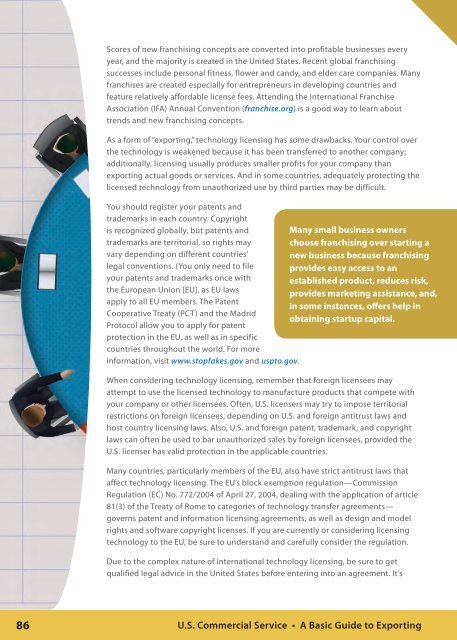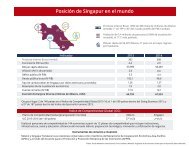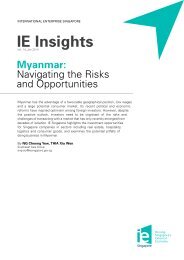basic-guide-to-exporting_Latest_eg_main_086196
basic-guide-to-exporting_Latest_eg_main_086196
basic-guide-to-exporting_Latest_eg_main_086196
Create successful ePaper yourself
Turn your PDF publications into a flip-book with our unique Google optimized e-Paper software.
Scores of new franchising concepts are converted in<strong>to</strong> profitable businesses everyyear, and the majority is created in the United States. Recent global franchisingsuccesses include personal fitness, flower and candy, and elder care companies. Manyfranchises are created especially for entrepreneurs in developing countries andfeature relatively affordable license fees. Attending the International FranchiseAssociation (IFA) Annual Convention (franchise.org) is a good way <strong>to</strong> learn abouttrends and new franchising concepts.As a form of “<strong>exporting</strong>,” technology licensing has some drawbacks. Your control overthe technology is weakened because it has been transferred <strong>to</strong> another company;additionally, licensing usually produces smaller profits for your company than<strong>exporting</strong> actual goods or services. And in some countries, adequately protecting thelicensed technology from unauthorized use by third parties may be difficult.You should r<strong>eg</strong>ister your patents andtrademarks in each country. Copyrightis recognized globally, but patents andMany small business ownerstrademarks are terri<strong>to</strong>rial, so rights maychoose franchising over starting avary depending on different countries’new business because franchisingl<strong>eg</strong>al conventions. (You only need <strong>to</strong> file provides easy access <strong>to</strong> anyour patents and trademarks once withestablished product, reduces risk,the European Union [EU], as EU lawsprovides marketing assistance, and,apply <strong>to</strong> all EU members. The Patentin some instances, offers help inCooperative Treaty (PCT) and the Madridobtaining startup capital.Pro<strong>to</strong>col allow you <strong>to</strong> apply for patentprotection in the EU, as well as in specificcountries throughout the world. For moreinformation, visit www.s<strong>to</strong>pfakes.gov and usp<strong>to</strong>.gov.When considering technology licensing, remember that foreign licensees mayattempt <strong>to</strong> use the licensed technology <strong>to</strong> manufacture products that compete withyour company or other licensees. Often, U.S. licensers may try <strong>to</strong> impose terri<strong>to</strong>rialrestrictions on foreign licensees, depending on U.S. and foreign antitrust laws andhost country licensing laws. Also, U.S. and foreign patent, trademark, and copyrightlaws can often be used <strong>to</strong> bar unauthorized sales by foreign licensees, provided theU.S. licenser has valid protection in the applicable countries.Many countries, particularly members of the EU, also have strict antitrust laws thataffect technology licensing. The EU’s block exemption r<strong>eg</strong>ulation—CommissionR<strong>eg</strong>ulation (EC) No. 772/2004 of April 27, 2004, dealing with the application of article81(3) of the Treaty of Rome <strong>to</strong> cat<strong>eg</strong>ories of technology transfer agreements—governs patent and information licensing agreements, as well as design and modelrights and software copyright licenses. If you are currently or considering licensingtechnology <strong>to</strong> the EU, be sure <strong>to</strong> understand and carefully consider the r<strong>eg</strong>ulation.Due <strong>to</strong> the complex nature of international technology licensing, be sure <strong>to</strong> getqualified l<strong>eg</strong>al advice in the United States before entering in<strong>to</strong> an agreement. It’s86U.S. Commercial Service • A Basic Guide <strong>to</strong> Exporting





